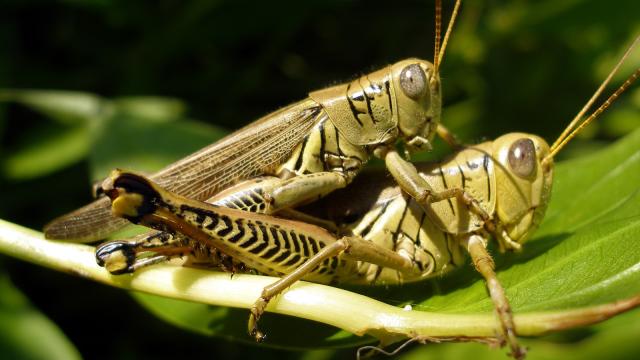You might not know this, but we’re in the midst of an insect shape-studying renaissance. MicroCT technology — basically a lab version of the CAT scanners found at hospitals — is increasingly allowing scientists to produce detailed three-dimensional images without destroying samples. So naturally, if we’re scanning everything, we might as well scan grasshopper genitalia mid-bang.
The wrong species of grasshopper, but they screwin’ (Image: Rkitko/Wikimedia Commons)
That’s right. Some researchers flash-froze grasshoppers doing the dirty and scanned them to understand their genitalia. They published their findings in the Journal of Morphology in January, but their copulatory findings were brought to our attention recently by Entomology Today.
The problem, you see, is that scientists don’t understand how grasshopper parts work during copulation quite as well as they’d like. So, to better elucidate our understanding of how grasshoppers get groovy, they imaged a set of genitalia with two guiding questions — questions that unite all things on the planet in our drive to understand ourselves and one another:
1. How does the male grasshopper genitalia work?
2. How does the female grasshopper genitalia work?
And of course: How do they screw?
These scientists, careful not to fall victim to the follies of others who forget to measure the vagina in favour of the far danglier penis, made sure to spend equal time on the female grasshopper’s bits.
[referenced url=”https://gizmodo.com.au/2017/04/you-have-no-idea-how-mysterious-whale-vaginas-are/” thumb=”https://i.kinja-img.com/gawker-media/image/upload/t_ku-large/tqfi6eh9djjnwfxk10z7.jpg” title=”You Have No Idea How Mysterious Whale Vaginas Are” excerpt=”Whale vaginas are an enigma.”]
“There’s been a belief for a long time that female insect parts don’t look that different across species,” Derek Woller, co-author of the study and a Texas A&M University PhD candidate, told Gizmodo. “It turns out in the grasshoppers I study that they are pretty different, but you have to open a lot of them and look pretty closely.”
The authors needed to search the literature for all of the proper terminology to refer to these parts — and then they needed specimens. They collected samples of the Melanoplus rotundipennis — this means round wing, not round penis, as you might suspect. These seemingly boring looking, brown, flightless grasshoppers came from museum collections, as well as the wild. But then they needed to get these grasshoppers to do it .
So, they set up a little sex den for our invertebrate porn stars, supplied them with some super-sexy romaine lettuce to feed the mates, and waited until the love bugs started banging. Then they flash-froze them in a -80C freezer. Brutal.
But once they scanned the bugs, they learned a whole lot about these complex components, and how strange they really are. Male grasshoppers have external parts to help support and latch onto the female parts. They also have an internal genital chamber, which contains a phallic complex, support structures for gripping and stimulating the female’s genital, an ejaculatory duct, and plenty of other structures for support and leverage. The female, meanwhile, has her own chamber designed to receive sperm and guide eggs, as well as a piece keep the whole thing shut.
The apparatuses lock together in the craziest copulative act you’ll hear about today: As Woller explained to us, the male grasshopper mounts the female, and flips the roof of his back end inside his body, pushing out the phallic complex which was previously inside his body. The male inflates the phallus like a balloon. The inflated genitalia hooks onto the female’s and inserts itself.
This might sound weird, but it gets even weirder across grasshopper species. You wouldn’t know the difference between the two dozen species Woller studies until you looked at their genitalia, which can be all different shapes and sizes. It’s kind of the way that Charles Darwin could tell the difference between finch species, but with genitals.
“Like Darwin’s sexy finches,” Woller said.
Luckily, if you have any more interest in grasshopper genitals, Woller would be “delighted to discuss the details”.
